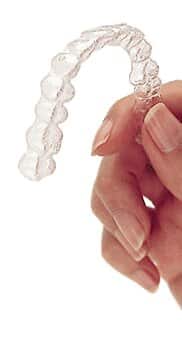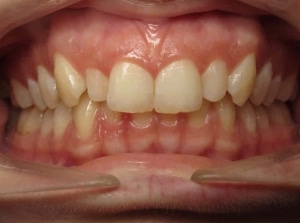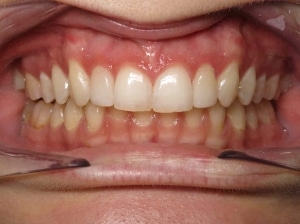Orthodontists Serving Denver, Cherry Creek, Stapleton & Nearby Areas Of Colorado

Would you like straighter teeth and a better bite? If you’re seeking a superior smile and you’d like to achieve that better look without metal wires and brackets, Denver orthodontists Dr. Robert Rudman and Dr. Birg can determine your suitability for Invisalign®.
To learn more, please call Advanced Orthodontic Care at 303-331-0222 today to schedule your free consultation. Dr. Rudman and Dr. Birg serves patients from Downtown and other communities in the Denver area.
What is Invisalign®?
This orthodontic method straightens teeth with clear, plastic aligners. They are customized to your teeth, jaws and bite. During treatment, you progress through multiple sets of aligners, typically wearing one set for a couple of weeks before graduating to the next. In this way, Invisalign is similar to braces in the way it gradually moves your teeth over time.

Invisalign® vs. Braces
Thousands of people avoid orthodontics because they can’t stand the thought of wearing braces. Whether you’re concerned about discomfort or the effect the apparatus might have on your smile, Invisalign® could be an ideal alternative if you’re worried about traditional orthodontic correction.
Invisalign® can treat many of the same issues affecting teeth and the bite as braces, including:
- Crooked teeth
- Crowded teeth
- Gaps between teeth
- Overbite
- Underbite
- Crossbite
- Open bite
Instead of brackets and wires attached to your teeth, Invisalign® treatment requires you to wear comfortable, removable plastic aligner trays for a portion of the day. The aligners are customized to fit the unique shape of your dental arch.
Who is a Good Candidate for Invisalign®?
There are a couple of things that can make you a good candidate for Invisalign® or not. First are the physical movement needs of your oral situation. Invisalign cannot achieve the dramatic movements of truly involved orthodontics. This would typically be traditional bracket and wire orthodontics that could also require headgear.
But you would be great for Invisalign® if you have mild to moderate repositioning needs. Invisalign can do the same heavy lifting as traditional orthodontics in these cases, and it can do so with far less hassle, and far less visibly!
The second criterion you could call diligence, commitment, dedication, those kinds of descriptors. Here’s what we mean. With traditional orthodontics, the bands and wires are on your teeth — you don’t get to take them off. They are working 24 hours a day, seven days a week.
That’s not the case with Invisalign®. You can take out your aligner trays when you eat and when you’re brushing your teeth and cleaning your aligners. That’s the beauty of the system. But you need to wear them the rest of the time…for at least 20-22 hours every day. There’s the rub. If you’re the kind of patient who could take out your aligners and not put them back in for a day or two then you’ll instantly lose all the progress you’ve made with that set. The system really needs dedicated patients to work successfully.
But it’s easy to be that person. You don’t feel the aligner trays when they’re on your teeth. Other people can’t see them. There’s no reason to take them out except when you’re eating, cleaning your teeth, and maybe playing trumpet in your high school band.
What People Say About Us!
Click here to read more reviews.
What Is The Right Age for Invisalign®?
Invisalign® is for both teens and adults. Watch the video below to learn more from Dr. Robert Rudman and Dr. Birg about the use of Invisalign for teens.

Check out the video below to learn more about how Invisalign treatments work for adults.

What Are The Advantages of Invisalign®?
Dr. Rudman and Dr. Birg are in the top 1% of Invisalign® providers worldwide. As a Denver Invisalign® Elite Preferred Provider, he has helped many patients enjoy comfortable, low-profile orthodontic correction.
Comfort and a nearly invisible aesthetic aren’t the only reason so many patients prefer Invisalign®. The removable design of the aligners allows you to:
- Eat what you want
- Engage in your favorite sports and activities without fear of damaging an apparatus
- Clean your teeth more easily than you can with braces
- Shift your teeth and bite into place by wearing the trays the recommended 20 to 22 hours per day
- Discard your aligner every two weeks and start using a new one for the next phase of treatment
Treatment with Invisalign® also requires fewer office visits than braces. While some braces patients have to schedule monthly checkups with their orthodontist, with Invisalign® you can plan on seeing Dr. Rudman and Dr. Birg every six to eight weeks for an evaluation of the treatment’s progress and to pick up your next set of aligners.
What Is The Invisalign® Process?
Typical steps in the process include:
- The consultation. First you will meet with Dr. Rudman for a consultation. You and he will discuss your goals for your smile and your specific bite issues. Once he reviews your x-rays he can determine whether Invisalign® is an option. He'll tell you all of your treatment options, including metal braces and clear braces.
- Mapping your teeth and treatment plan. No goop or putty required! We will take a digital scan of your entire mouth with a small, handheld wand. Dr. Rudman uses this scan to map out your entire treatment. It's completely customized to you. The Invisalign® lab uses these plans to create your plastic aligners.
- Getting your first set of aligners. We schedule your next appointment based on when the aligners are ready. Dr. Rudman makes sure the aligners fit and that you know how to take them on and off. Our team makes sure you get all of your questions answered and that you know what to do. We schedule your next appointment at this time as well.
- Returning to the office for routine appointments. You receive batches of aligners every visit, and receive the new batch every 6-8 weeks at your regularly scheduled appointments. It is normal to feel pressure and tightness the first few days after wearing a new set of aligners because they will be moving your teeth.
- Seeing your final results. Because of the nature of Invisalign®, there isn't really a grand reveal at the end of treatment; you will be able to see your progress every step of the way. Nonetheless, completing your treatment is an important achievement.
The length of treatment varies by patient. It depends on the bite and teeth misalignment present, and what movements need to happen in order to straighten them.
How Long Will My Invisalign® Treatment Take?
At Advanced Orthodontic Care, we’ve found that the average treatment time for our Invisalign patients is about one year. Of course, every patient’s situation is unique, so this is just a rough average. Minor movement could take less time; more involved movement could take more time. Another nice thing about this system is that if, at the end of your proposed treatment, we feel you could still use a little more adjustment, we can simply order more aligners.
Life with Invisalign®
Invisalign® allows you to live your life without missing a beat. While brace are the right option for some people, Invisalign has certain advantages if you are a good candidate. You can eat, play sports, and continue all of your normal activities without having to worry about making accommodations:
Maintain the same lifestyle.
With braces, you have to avoid certain foods, particularly those that are firm, crunchy, sticky or chewy. Since you remove Invisalign® to eat, you can enjoy any foods you like without worries about bent wires and brackets. You also remove the aligners if you play sports like football, soccer, track, etc. You won't have to worry about breaking braces during these activities.
Take the aligners out when life requires it, such as popcorn at a movie or a cup of coffee with a friend.
Enjoy the ease of removable aligners.
There is no special dental hygiene method required while undergoing Invisalign® treatment. Remove the aligners to brush and floss your teeth like normal. We show you how to clean the aligners lightly each night so that they stay clear and transparent.
Although you need to visit us for regularly scheduled appointments, you are typically spared the possibility of emergency visits when you wear Invisalign®. While braces can bend, break or dislodge, Invisalign® tends to be a little less vulnerable (as long as you follow all guidelines). Braces tend to get damaged if the patient eats something chewy, firm or sticky. This requires a repair appointment. The plastic aligners are removed before you eat, so they are spared from these types of problems. Nonetheless, it is very possible to damage the aligners in other ways. Without proper storage and care, they can warp, discolor or scratch. We make sure you know how to care for them so these problems don't arise.
Invisalign - Before & After


What Happens If I Forget To Wear My Aligner Trays?
As mentioned above, for Invisalign® to be effective, you need to get in the habit of wearing them all of the time, except when you’re eating and cleaning your teeth. If you forget to put them back in one night after having a late-night bowl of ice cream that’s not going to ruin anything, but it should be the exception. Each aligner needs to keep the subtle pressure on the teeth to move them, and this requires 20-22 hours a day.
How Do I Take Care Of My Invisalign® Aligners?
Keeping your aligners clean is easy. We’ll walk you through this as you’re getting started, but here are different options for cleaning your aligners:
- When you remove them, immediately rinse them in water to remove the saliva.
- Soak your aligners once a day for 30 minutes in denture cleaner, Retainer Brite, a 50/50 mix of hydrogen peroxide and water, or in the Invisalign cleaning crystals.
- Clean your aligners with clear antibacterial soap. This gets rid of bacteria and is easy and inexpensive. You simply squish the soap around with your fingertips to clean the trays. But don’t use colored soaps, as they can tint your aligners.
- Gently brush your aligners with your toothbrush, but don’t use an abrasive whitening toothpaste. Pick a mild toothpaste and use a very soft bristled toothbrush. You don’t want to scratch and create pits in your aligner trays.
It’s important to clean your teeth after eating, if possible, as placing Invisalign® aligners on dirty teeth can make the aligners smell and it can allow decay to get started on your teeth.
What Happens After Invisalign® Has Moved My Teeth Into The Proper Positions? Will I Need To Wear A Retainer?
Once your teeth have been moved to where Dr. Rudman, and you have agreed is the perfect location, there’s nothing left to do with your Invisalign® aligner trays. You won’t wear them any longer. Your teeth won’t need special cleaning or anything.
But, just as with traditional orthodontics, after your teeth have moved it’s important to keep them from trying to move back to their original, flawed positions. With traditional braces, that’s where retainers come in. They usually click into the roof of the patient’s mouth and a wire wraps around the teeth to keep them in place. The problem with retainers is that the hard plastic can be uncomfortable. Plus, since you only have one retainer, it can begin to have an odor over time.
Invisalign® doesn’t use a retainer with a plastic piece that snaps onto the roof of your mouth. Instead, Vivera® retainers made from the same material as the Invisalign® aligners keep the teeth in place. These Vivera® retainers are similar to the aligners, but they are thicker and more durable because they need to be worn for longer than just a couple of weeks. You will receive four Vivera® retainers to be swapped out over the course of your retention period.
Invisalign Myths and Misconceptions
Aligner Trays Work the Same for Everyone
Everyone's mouth is different, and your teeth change with time. While therapies like Invisalign work flawlessly for a broad range of patients, things like your age and habits impact how effective they are.
You Can Use Aligner Trays Without Seeing a Dentist
It's essential to talk to a dental specialist before trying Invisalign. A thorough consultation is the only way to know whether this treatment is the best option. You'll also need to get your teeth scanned digitally to create the custom aligners.
Dental Aligner Trays Can Expose You to Harmful Chemicals
Aligner trays like Invisalign are specifically made to minimize your exposure to harm. They're free of industrial chemicals like bisphenol A (BPA), which has links to serious health problems. Plastic trays also avoid breaking down while being subjected to saliva, heat, and movement inside your mouth.
Invisalign Is a 100 Percent Successful Treatment
No dental therapy is guaranteed to work in every case. The failure rate for Invisalign is low thanks to a few factors. A majority of patients succeed with this therapy, partially because they go through extensive consultations with their dentists first. Invisalign has also been around for over two decades, and many people use it to this day.
Contraindications
Invisalign isn't for everyone. Some reasons you might want to try another treatment include:
- You've had premolar teeth extracted: Usually, your teeth help keep each other in place. But if you've had extractions, your remaining teeth can shift and tilt. Dental trays aren't strong enough to prevent this movement.
Your alignment problems are too severe: There are many different kinds of dental misalignment. Invisalign might not be advisable in certain cases, like if you've got significant gaps or severely tilted teeth. Talk to our dental team for a personalized assessment.
- You have an overbite: Not all types of overbite are correctable with dental trays.
- You have periodontal disease: If you suffer from gum disease or cavities, you should deal with these issues first. Invisalign therapy is best left for after you've worked on improving your oral health.
Are There Any Disadvantages to Invisalign?
This treatment isn't for people who think they'll be unable to follow the instructions. It's critical to wear them for 20 to 22 hours daily and remove them while eating.
Some people notice teeth and gum soreness after removing their aligners. This may limit the types of foods you can eat comfortably, but you'll still have more dietary options than you would with braces.
You might also notice changes to your speech. Dental aligner trays interfere with how your tongue and teeth work together, which can cause a minor lisp. Dr. Rudman and Dr. Birg can recommend speech exercises to help minimize this, and most patients adjust quickly. It's also worth noting that most people's speech changes aren't noticeable to those around them.
Why Do Dentists Not Recommend Invisalign for Severe Bite Problems?
Good dentists put patient well-being first. This means they'll avoid recommending treatments that aren't as likely to work. Invisalign and other clear aligners that straighten teeth without metal are less effective for highly complex issues.
These therapies started as a way to treat mild to moderate position problems, so it makes sense that they can't fix everything. If your bite problems are extreme, you might be a better candidate for something like braces. Invisalign may also be less effective for issues like tooth rotations.
Schedule a Consultation
If you are interested in improving your smile with our Denver Invisalign® treatment, please contact Advanced Orthodontic Care or call 303-331-0222 today to schedule your consultation. Dr. Rudman serves adults and teens in Denver communities including Stapleton, Downtown, and more.


